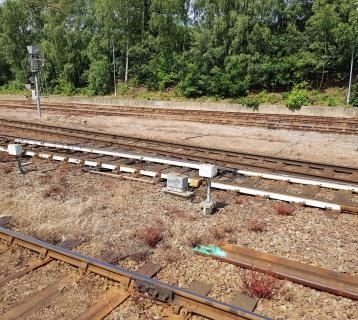Published on: Friday, 19 June 2020
Last updated: Thursday, 30 July 2020
Hotter summers are affecting many aspects of life in the UK and the railway is no exception, particularly here in East Anglia where we tend to see some of the highest temperatures.
Every year we work alongside Network Rail to ensure we are prepared for the season and the challenges it always brings, but sometimes the only option to ensure that we can still operate safely, and keep trains running is to slow the trains down.
We are sorry for the impact this has on your journey if it happens. Here’s an explanation of how heat affects different parts of the railway, why speed restrictions are sometimes necessary and how we try to minimise delays and cancellations to services:
Tracks and signalling
Metal rails expand and contract in different temperatures. Network Rail engineers make sure that our rails can carry trains in summer temperatures to around 27 degrees - the UK mean summer rail temperature. The rail can withstand some degree of change in temperature either side of this.
However, when the air temperature is 30 degrees, the temperature on the rails can actually be up to 20 degrees higher, exceeding the maximum temperature our rails are designed to cope with.
The problem is that when steel rails get hot, they expand, and this can cause a type of signalling problem called a track circuit failure and in extreme cases can cause a buckled rail.
If a rail buckles, then the train service will not be able to run at all until the buckled rail is replaced with a new one.
When Network Rail assesses that the temperature of the rails is going to exceed what it is designed to cope with speed restrictions are put in place to help prevent buckled rails.
A train going over a hot rail at a slower speed exerts less pressure on the rail and will help to prevent it buckling. It means have trains have to run more slowly, and there will be fewer trains as a result, but this is better than causing a bigger problem and then being unable to run any trains at all.
However, one solution that is helping to keep the track cool is to paint it white.
Network Rail paints rails white at critical points on the network so they absorb less heat, which reduces expansion.
Typically, a rail painted white is 5°C to 10°C cooler than one left unpainted.
Overhead wires
Overhead wires give power to the trains by conducting electricity through the pantograph on top of the train.
Some of these wires are very old and during hot spells they can expand and sag in the heat.
This can cause the train’s pantograph to become entangled in the wires which could even pull them down, resulting in delays and cancellations while the complex repairs are carried out.
Recently, Network Rail has replaced much of the ageing overhead wires with a new system that can cope with all the temperature changes and we are already seeing the benefits of this.
Modern overhead lines, such as those in place on the lines between Norwich, Ipswich, Colchester, Clacton, Harwich, Braintree, Cambridge and London Liverpool Street, and those recently installed on the Southend line, do not sag in high temperatures, avoiding the need for precautionary speed restrictions.
Since the overhead line replacement on the Great Eastern Main Line and the Southend line, Network Rail has removed heat-related speed restrictions between Ilford and Seven Kings and Shenfield to Billericay, with further restrictions to be removed following competition of the work in March 2020.
Trains
Our fleet maintenance teams will be doing everything they can to ensure that the air con on our trains is in working order.
Thanks to the introduction of our new trains, more of our routes will benefit from trains that have really good air conditioning systems this summer. Our old 1 and 2 carriage trains that ran on rural routes in Norfolk, Suffolk, Essex and
Cambridgeshire didn’t have air conditioning so we are pleased that passengers on these routes will now be kept cooler thanks to the new trains running on those lines, which all have air conditioning.
We’ve also switched off the heating on all our trains. On some of our older trains, you may feel warm air blowing through the vents at times on hot days if the train has only just started up – much like how your car blows through hot air from outside until the air con kicks in.
However, if you do board a train that feels uncomfortably warm please report it on twitter to @greateranglia or contact our customer relations department on 0345 6007245 (option 8) or [email protected] and let us know which service you are travelling on and the carriage number if you know it which is usually displayed above the internal carriage door.
If the problem is caused by a fault, we can then arrange for repairs to be carried out, sometimes by using a mobile engineer who can board the train to try and fix the problem whilst it is in service, or by scheduling it to visit a depot overnight.
Remember to keep hydrated while travelling. Take a reusable water bottle with you and make use of our free water refill fountains at some stations.
We will be doing everything we can to get passengers from a to b reliably and in comfort.
Please check before you travel
Where possible, we will try to make you aware in advance of any predicted timetable changes due to hot weather.
Please check how trains are running before you travel at www.greateranglia.co.uk or the Greater Anglia app



